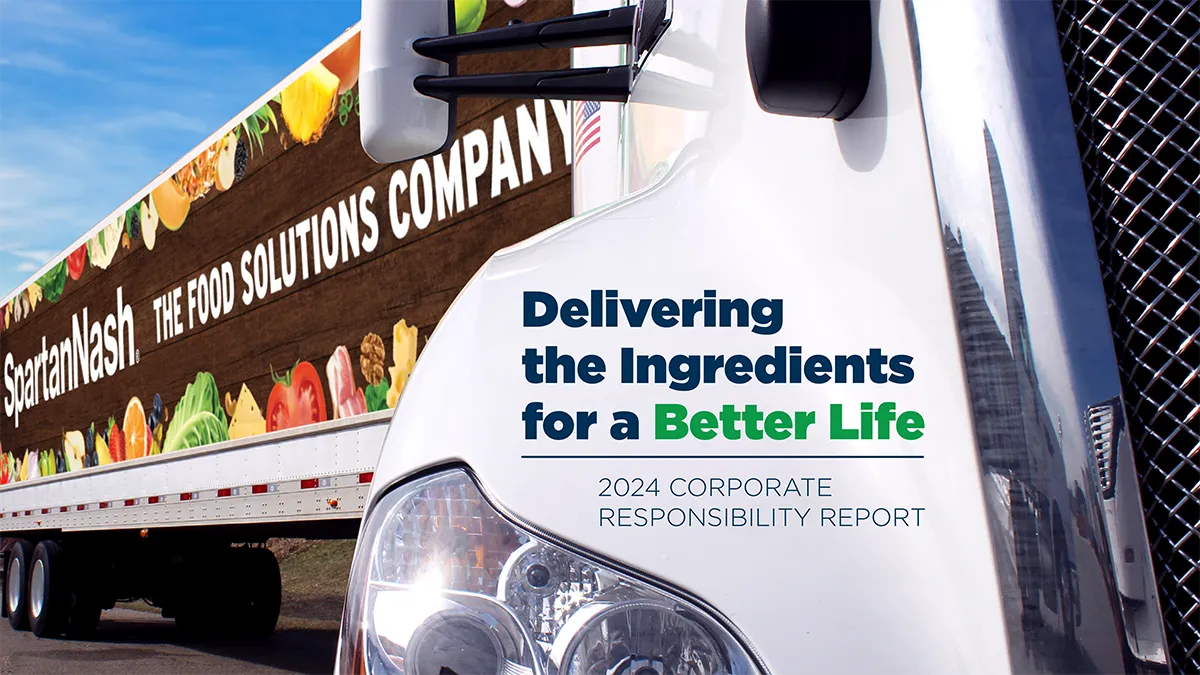Our Commitments
SpartanNash’s success relies on the strength and wellbeing of our Associates, customers and communities. We remain focused on creating stakeholder and shareholder value by aligning our initiatives with our Company’s strategic priorities.
We believe responsibility and accountability must lie within every function of the Company. Established in 2022, our governance structure promotes cross-departmental collaboration through a Corporate Responsibility Committee sponsored by Executive Leadership Team (ELT) members with subcommittees.
Please see our Corporate Responsibility Report for more detailed information.
2023-2025 Goals
In 2022, SpartanNash developed goals to be measured from Jan. 1, 2023 through Dec. 31, 2025. Each goal’s progress is measured against a 2021 baseline. The Company has continued to make meaningful progress toward these defined goals, and our efforts reinforce SpartanNash’s commitment to being a responsible business and good neighborhood partner.
Environment: We set out to improve our Ton Miles Per Gallon (TMPG) rate, and we have seen a 7.7% improvement due to initiatives that have improved our supply chain efficiency.
Safety Leader: As part of our commitment to a People First culture, we set a goal to achieve top-quartile safety performance. We have achieved a Total Recordable Incident Rate (TRIR) of 2.0, which represents the top quartile under the U.S. Occupational Safety and Health Administration (OSHA) guidelines. We have reduced our TRIR by 25% year-over-year, and we are on track to meet our long-term goal of having reduced incident rates by 35% since 2021. In recognition of our progress, SpartanNash received the 2024 Theo Award from National Comp and Risk & Insurance for excellence in injury reduction, improved medical outcomes, safety improvements and return-to-work efficiencies.
Culture: To build on our People First culture, we strive to create an environment where our Associates reflect and understand the communities we serve, and where all Associates feel valued and support each other. We’ve continued to work to attract, recruit, retain and promote people representing a wide range of backgrounds, experiences and skills. To further engage a wide range of job seekers, we made enhancements to careers.spartannash.com, showcasing our People First culture, career opportunities, Associate Resource Groups, support for the military, and more. Additionally, we introduced our People Philosophy, Competency-based interview guides, and training for hiring managers to ensure an equitable hiring process. Leadership development remained a priority with new partnerships with DiSC, Korn Ferry, LinkedIn Learning and Skillsoft, providing team leaders with high-quality training. We expanded our Competency-based development for people leaders, reinforcing our commitment to professional growth and career advancement.
Talent: In addition, SpartanNash continued to invest in early career development to build a strong talent pipeline, further expanding our internship program. In 2024, we welcomed 106 interns from nearly 40 colleges, providing hands-on experience and career development resources to help our interns grow. Based on business needs and intern skill sets, we continue to convert as many interns as possible to full-time positions.
Community: In terms of our community impact, we set a long-term goal to provide 20 million meals through food and funding to those in need by the end of 2025. In 2024, we contributed almost 6.4 million meals, putting our total meals donated at 12.6 million. Donations were made from our grocery stores and distribution centers, which included eligible close-dated products to reduce waste; as part of our disaster relief program; corporate donations; and donations through the Our Family® Cares program.
Board Composition: Our final goal involved maintaining an ongoing focus on Board refreshment to ensure we have a strong mix of skills and experience. In 2022 and 2023, we added six new independent board members, including Fred Bentley, Jr., Kerrie D. MacPherson, Julien R. Mininberg, Jaymin B. Patel and Pamela S. Puryear, Ph.D. In 2024, we welcomed Dorlisa K. Flur to the Board of Directors.
The progress we’ve made with our long-term goals reflect SpartanNash’s ongoing commitment to corporate responsibility and creating long-term value for our key stakeholders.
Corporate Responsibility Reports
This comprehensive report provides a detailed overview of all topics deemed material to the Company’s current and future operations, including data across operational activities.
Click the image above to download SpartanNash’s Corporate Responsibility Report.
